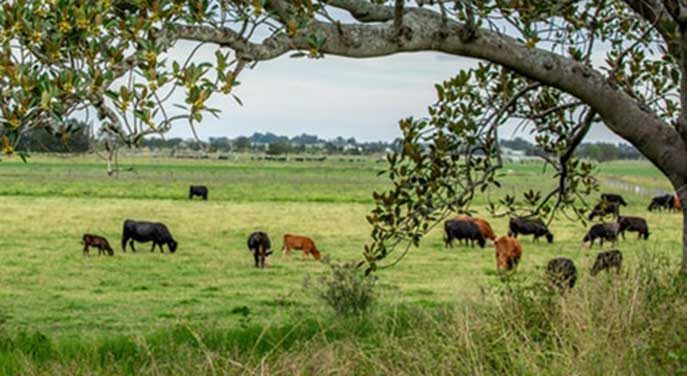Ranchers who frequently rotate cattle between fields – resembling how bison once moved across Canada’s prairie – build drought resistance into Western Canada’s grasslands, according to a series of University of Alberta studies designed to find ways to improve the net carbon balance of grazed grasslands and nurture more resilient landscapes.

Timm Döbert
“The way we manage those grasslands has far-reaching implications for biodiversity, climate and food safety,” said Timm Döbert, post-doctoral fellow in the Faculty of Science and lead of a recent study published in the journal Geoderma.
For the five-year project, the team looked at adaptive multi-paddock (AMP) grazing, a type of rotational grazing characterized by high animal unit densities, small paddocks and short periods of grazing followed by a long rest period.
“The conceptual idea of this type of grazing is to graze a relatively small area for a short period of time and at a high animal density, followed by an extended period of rest for vegetation to fully recover,” said Döbert. “It’s meant to reflect the more natural grazing patterns under which these grasslands have evolved, including the herding impact of bison in a North American context, but generally speaking, the herding effect of wild animals.”
Up to 34 AMP ranches were paired against “neighbouring ranches,” which at the far end of the spectrum are essentially an open field where cattle roam freely but also include those ranches that rotate their herds less often. They also have, on average, a 30 times lower rest-to-grazing ratio and a 23 times lower mean livestock density per paddock than AMP ranches.
The researchers found that AMP ranches have 30 percent higher water infiltration than neighbouring ranches.
“The western grasslands are an ecosystem that is water limited, so if we can identify on-field management changes, which are fairly easy to implement, and then have such a strong benefit for water infiltration, this will provide ranchers with potential strategies to better adapt to a changing climate,” said Döbert.
In contrast to extended rest, direct animal impacts, including cattle stocking rate, showed minimal or even negative impacts on infiltration, supporting the common notion that grazing at moderate or low stocking rates is favourable for grassland health.
Regardless of the grazing approach, higher animal numbers generally resulted in an increase in CO2 emissions, as shown by another study in which Döbert was a co-author, published in the journal Science of the Total Environment. However, methane uptake in the soil was 1.5 times greater on AMP-grazed ranches than on their neighbouring counterparts.
“It appears that lower animal numbers not only decrease greenhouse gas emissions but benefit water dynamics in Western Canada’s grasslands,” said Döbert.
“If you have more animals than the land can sustain, you start to get into land degradation issues – and way too much can even lead to desertification scenarios.”
Döbert explained grasslands naturally cover more than 30 percent of the land on Earth’s surface and are critical for providing ecosystem goods and services, safeguarding wildlife and mitigating the impacts of a changing climate.
However, large tracts of Western Canada’s grasslands have been lost to agricultural conversion over the past two centuries and what remains is mainly used for livestock grazing.
“We lose an enormous amount of soil carbon in the conversion process,” said Döbert. “You can point the lever in the right direction, but it’s really protecting the grasslands in the first place that is so critical for avoiding additional CO2 emissions.”
Short of that, he noted the backdrop for this project was to establish the science that can be used for developing carbon offset protocols.
“Yes, at lower animal numbers, ranchers might get less money through their livestock directly, but they might receive financial support for their stewardship of the land as an additional channel for income.”
Additional results on soil organic carbon, plant community function and diversity, the soil microbiome and socio-economic aspects of AMP grazing will be published over the coming year.
The project was initiated under the federal Agricultural Greenhouse Gases Program of Agriculture and Agri-Food Canada.
The work was spearheaded by ecologist Mark Boyce in the Department of Biological Sciences, in close collaboration with an interdisciplinary team of scientists including Edward Bork, Scott Chang, Scott Jeffrey and Cam Carlyle in the Faculty of Agricultural, Life & Environmental Sciences.
The studies were published in Geoderma, Science of the Total Environment and Agronomy.
| By Michael Brown
Michael is a reporter with the University of Alberta’s Folio online magazine. The University of Alberta is a Troy Media Editorial Content Provider Partner.
The opinions expressed by our columnists and contributors are theirs alone and do not inherently or expressly reflect the views of our publication.
© Troy Media
Troy Media is an editorial content provider to media outlets and its own hosted community news outlets across Canada.


